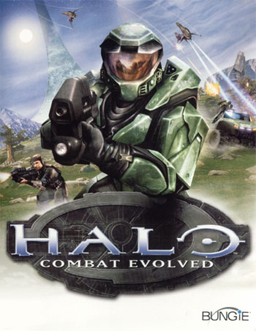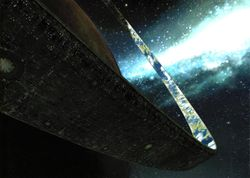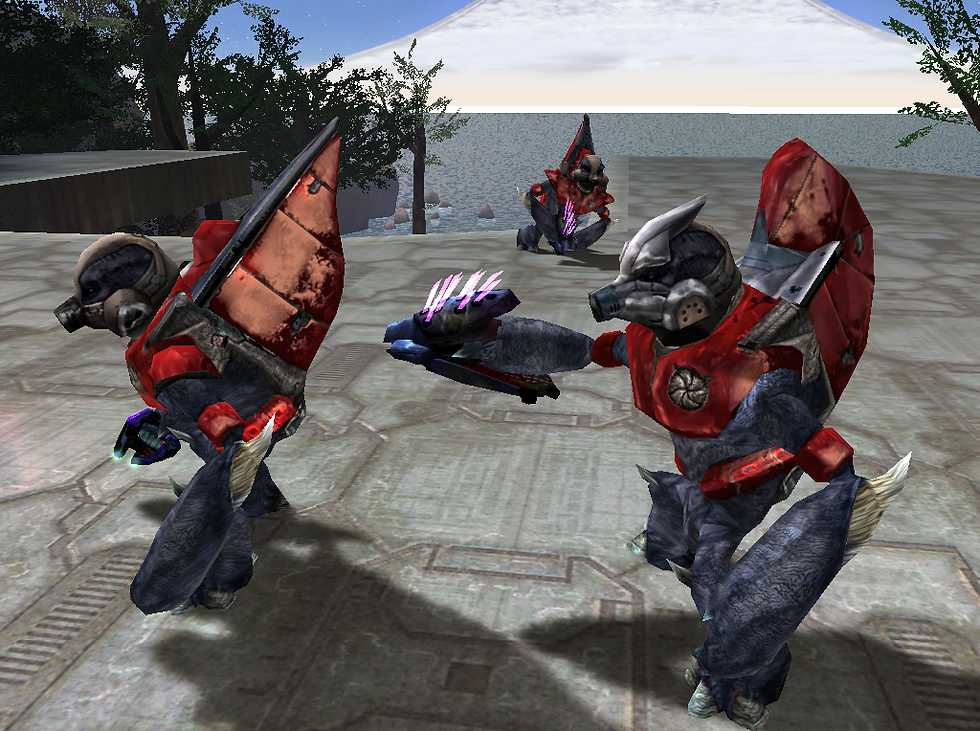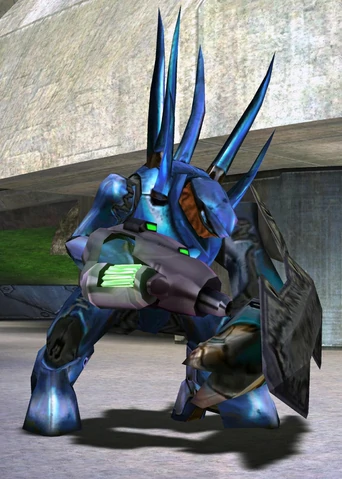Halo Combat Evolved (2001) for Xbox
- Sam Cawley
- Aug 4, 2021
- 10 min read
Updated: Aug 31, 2021
My journey through the Halo universe started with Halo 3 for Xbox 360, which in hindsight was the worst place to start off and to make things more confusing my next game was Halo Reach, which is actually a prequel to the whole franchise. Needless to say despite being behind on the story for so long it's quickly become a personal favourite to play over and over again.
But every story starts somewhere, so allow me to dive right into the beginning of my favourite gaming franchise of all time, Halo: Combat Evolved.

History
Halo's existence is heavily owed to Microsoft and the invention of the Xbox. Which is still visible today as it's still the flagship title for the Xbox brand and the face of the company.
But before it became the Xbox's golden goose, it started life with a small games company called Bungie.
Bungie were a little company with some successes under their built, creating games for PCs such as Myth, a tactical fantasy series, and Marathon, a first person shooter much like Doom.
Unfortunately they ran into a bit of trouble, that nearly destroyed the company as they knew it. A huge technical issue in one of their games would delete a users hard drive if the game was uninstalled and led to a monumental product recall of all the defective discs containing the game.
It could have been the end if it weren't for Microsoft, who acquired Bungie as a developer, tasking them with creating a game for their big step into the gaming market, the Xbox.

During this time Nintendo and Sony were leading the gaming industry, with poor Sega bumbling behind trying to keep up with the latest consoles and games. Microsoft however rammed straight into the industry with the announcement of their Xbox console and the best way to market a console is the games, or more specifically the exclusive games.
Xbox needed a standout game, something that'll bring in customers, and cement their console as a key player in the console wars, and that's where Bungie came in.
They were to create Halo, a project they'd already been working on but hadn't been finalised, going from a top down, tactical perspective game, to a third person shooter, until eventually becoming first person and launched along side the Xbox on 15th of November, 2001.
Before diving into the game itself, I want to briefly talk about the chaotic making of Combat Evolved. As mentioned before Halo was something Bungie had loosely worked on but never had a concrete idea of what it was. By the time they were acquired by Microsoft, it was a coagulation of random ideas without structure, and Bungie had to turn it into a full game, for a console they hadn't seen before in less than a year. Enormous amounts of content was cut down, including levels, story elements, an open world to explore, and much more. Huge strain was put on staff and the music used for the announcement trailer was finished just days before its presentation, which in today's industry, simply wouldn't work.
But despite all that chaos, Bungie managed to create a gaming experience that set industry standards for years to come and a franchise so beloved that it still brings fans of all ages to its newest releases
Story
Halo CE's story isn't really anything spectacular. As far as sci-fi stories go, it's pretty barebones with a few interesting moments that set up future plot points for additional games. However when you look at it for what it is and ignore how later games built off it's foundations, it's not very special.
It starts out as your standard us vs them storyline. Opening on a human spaceship called the Pillar of Autumn, we meet Captain Keyes and the ship's AI Cortana (not the one you see on smartphones). They're piloting the ship in an attempt to escape pursuing aliens known only as the Covenant and we get some context clues that humans and the Covenant have been locked in a war for quite a while.
In their escape attempt, the Pillar of Autumn has stumbled upon a large, ring shaped world that they've never seen before, but they have no time to think about, as hostiles are on their way with the intent to board the ship and kill anyone on it. Captain Keyes and Cortana bring the crew up to speed and awaken "an old friend" the Masterchief, a super soldier in a suit of armour who you control.

Fighting your way through the opening level, Masterchief is tasked with escaping the Autumn with Cortana, in order to keep her safe, while the Captain goes down with the ship in an attempt to land on the mysterious ring world.
After Chief lands on the ring himself, he goes on a rescue mission to save as many marines in the area as possible, before finding out the Captain survived the crash and is being held captive on one of the alien ships.
Planning a daring rescue mission, Chief and the human forces rescue Keyes and learn that the ring world they've landed on is called Halo, and the Covenant believe it's a weapon that they can use against the humans.

With this revelation, the next objective is to locate the control room to this superweapon and capture it first before humanity is wiped out, but along the way, a dark mystery begins to unravel itself.
Chief is introduced to a new threat other than the Covenant, an ancient and destructive enemy, that has the ring has contained for years, which has now been set free because of the conflict brought to Halo's surface. Alongside this new threat, another faction has awakened to fight it, the protectors of the ring, led by a suspicious character who seems desperate for you to activate Halo, proclaiming it's the only way to save the galaxy, is this a friend or foe?
After coming close to activating the ring's weapon, Chief and Cortana discover Halo's true purpose, a galaxy cleansing device that wipes out all sentient life, supposed to be used as a last resort to wipe out the ancient enemy so it doesn't take over everything.
Chief and Cortana know that they can't allow the ring to exist, knowing that it's too dangerous for anyone to control and manage to destroy it it completely before making their escape, the last survivors of a grisly campaign.
I know it's nothing ground breaking, but it set Halo on a path to becoming one of the most story rich sci-fi worlds ever created. Games and novels build off of CE's foundations and the story from CE has just enough mystery and action to keep it entertaining from start to finish so I have to give it credit for that.
Gameplay
The gameplay of Halo CE is, in my opinion, timeless. Everything that was designed in its gameplay loop was made to be fun, and it still shows to this day. Something I find particularly appealing is how it can strike a balance between action and contemplation. What I mean by this is how you move through the levels, through quiet, more exploration focused segments, to battles with the enemy factions. A perfect example that's shown as the gold standard for this is the second level, which is rightly called "Halo."
The level begins after a crash landing on the Halo ring, literally stepping foot on an alien world vastly different to Earth. The game makes this clear by putting Masterchief in the middle of a large canyon, with a perfect view of the rest of the ring, with terrain that looks somewhere between natural and artificial.

You have just enough time to take in the scenery until Cortana alerts you to a Covenant ship on its way, encouraging you to move on. You work your way up the canyon until emerging on a plateau, where friendly forces are taking cover in a gigantic metal structure, its grey, metallic shine contrasting the green terrain, looking so out of place yet still fitting the aesthetic. There's no explanation as to what it is, why it's there, and rightly so, because you're too busy fighting off attackers to ponder what it's doing there.
After securing the area you're given a vehicle and you're setting off to find more friendlies in need of a rescue, entering a metal tunnel leading to a enormous room illuminated by faint blue glows, and a working bridge mechanism connecting it to a way out.
You're met with similar structures until the end of the level, leaving the ring's origin in the back of your mind while mowing down aliens, but still reminding you that you're not anywhere remotely safe, you're not home, you're just somewhere.
This is what I think Halo CE does best. It immerses you in the atmosphere of the game while still giving you fun combat segments like any game would, and while the graphics don't necessarily hold up to today's standard, they don't ruin the experience because they're designed in service of the game, and that shows most in the enemy design, another one of Halo's strengths.
There are three factions of enemies in Halo CE, the Covenant, and two secret ones, all with variants of enemies that perform different actions or pose different threats in a fight.
The Covenant are the easiest to use as an example of this. There are four Covenant enemy types.
The Grunts are as the name implies, they're small, appear in large numbers and are the easiest to kill. Their threat comes from being in large groups or if they surround you but they're never too difficult.

Jackals, are a shield enemy, sporting a circular energy shield that protects them until it sustains enough damage. They're faster than grunts and difficult to kill unless you can get past their shield before they get past yours.

Elites are your equals in terms of posing a threat. They're tall, nimble, and have plenty of ways to take you down. Whether it be weapons, grenades, melee or in a vehicle, they're ones to watch out for. To make things harder they have an energy shield to destroy before finishing them off and come in three colours to signify rank and strength. Blue are the minors and by far the easiest. Red are Majors and are slightly more challenging and gold are the Zealots, the deadliest and often have some of the strongest weaponry, such as the energy sword, which can kill you in a single swing if they get to close.

Finally Hunters, a rarer enemy, only appearing in certain levels, and act as the muscle. Heavily armoured except for a weak spot on the joints and back, and packing incredible strength and destructive cannons.

All enemy types serve as pieces on a chess board, having their strengths and weakness making fights almost like their own puzzles, where you tactically decide what order, or how to take down groups of enemies, which makes replaying the game a joy as each time can be different depending on how you plan an engagement and how the AI responds.
I've always argued the difficulty to Halo CE is just right too. There are four to choose from, Easy, Normal, Heroic and Legendary. The only thing that I'm critical of is Legendary. It's fine, and works how it should be, but there are certain levels that just feel too intense. By this I mean levels that involve large hordes of enemies in close encounter areas, and combining this with a lack of checkpoints, which tends to happen quite a bit in my experience, it can easily get frustrating and feel unfair. However this is a minor grievance I personally have and doesn't impact my opinion on the game.
Finally the controls themselves feel fluid, there's never a point where you can't react quickly to something going on or dodge incoming fire. Movement speed is quick and first person aiming is snappy and it feels good to combine moving and aiming to suit the situation, whether it be side stepping while shooting or retreating from a tough spot.
Overall I think from a gameplay standard, Halo CE is incredible. It blows my mind that this game is 20 years old and is still so much fun to revisit. I also find it amazing that it actually does things better than modern day shooters in terms of its design and gameplay loop. It's a lot of fun, and if you take the graphics for what they are, you're still left with an entertaining game with hours of fun to be had, which you can also do with a friend, the best way to play Halo.
Audio
What can I say that hasn't already been said over a hundred times about Halo's audio design. It's fantastic. I'll start with the sound itself. Halo CE packs so many distinct sounds that somehow still have a purpose in the way you play the game. Weapon sounds match the power of a weapon perfectly, whether it be the sonic crack of a sniper rifle or the shredding noise of the assault rifle, you can feel how strong a weapon is by the noise it makes when you fire it. It's also incredibly satisfying to listen to.
On top of this the enemies have certain audio cues which let you know what you're fighting even if you can't see them and it even has some tactical advantages if you learn to listen. For example, taking down an elite in a squad of grunts can sometimes cause the grunts to panic, flinging their weapons up and attempting to flee because their leader is gone. On this occasion, they'll typically announce that they're doing this by exclaiming something along the lines of "leader dead! run away!" which is your cue to run up while their back is turned and take them out with no problem at all. This applies to close quarter combat as well and gives you the chance to identify what you're turning the corner to before you even face them and again, gives you that immersive feeling.
It would be absolute heresy to talk about Halo's audio and not discuss the music. Composed by the legendary Marty O'Donnell, the music tracks provide that perfect blend of combat and contemplation that I mentioned earlier. Angelic harmonies during landscape reveals can lead into engaging rock music when you enter a battle which summarises from Halo is all about, killing aliens in gorgeous locations. Atmosphere has always been something media strives for in a story, and Marty's score brings that atmosphere, without overstaying its welcome, and it's hands down one of my favourite things about the series and I'm sure I'm not the only one.
Conclusion
As I've probably made it painfully clear, Halo means a lot to me. I probably wouldn't be as into videogames as I am if I hadn't played it all those years ago and for that I'll always hold it in a special part of my heart for that. As for Halo CE, while it doesn't personally hold that nostalgic value that Halo 3 does for being my first Halo game, I still love it for what it is and from a historical standpoint it deserves to be considered as a masterpiece in game design. Playing it is still a load of fun today and as mentioned previously, in my opinion, it's timeless and will always be the starting point to something beautiful.






Comments